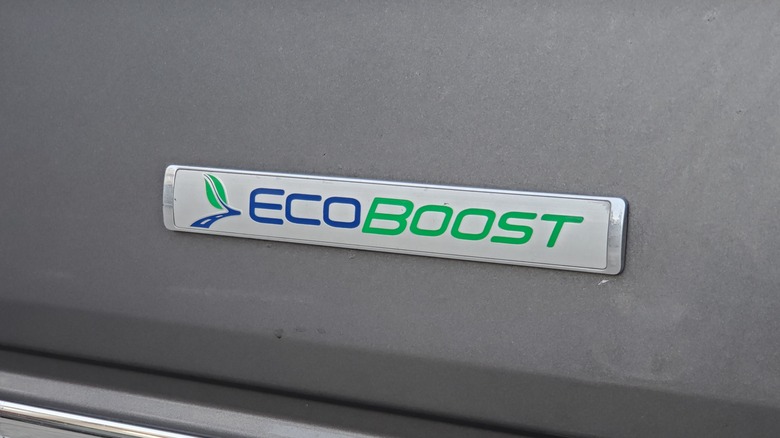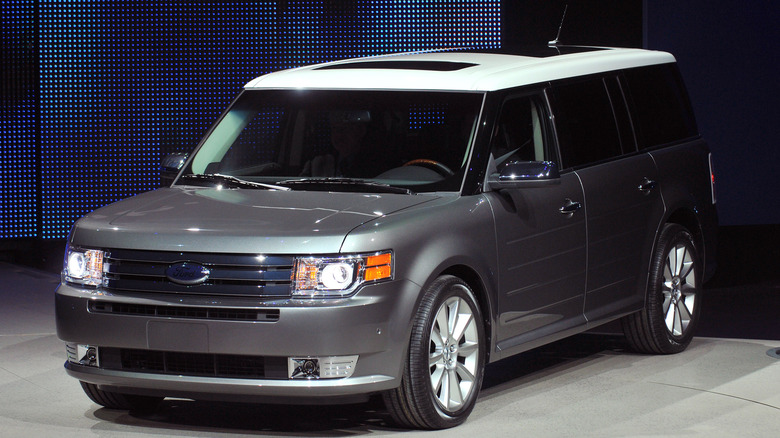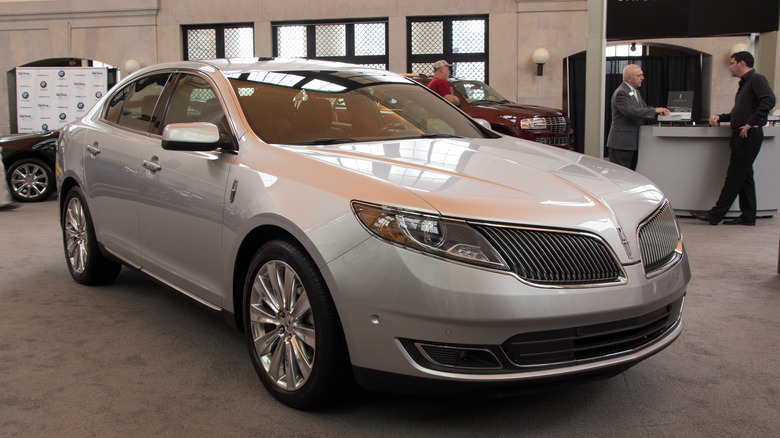Every Ford Model Powered By The 3.5L EcoBoost V6 Engine
Though electric cars are becoming more and more common today, gas engines are still preferred by many enthusiasts. While they have an obvious flaw in negatively impacting the environment, Ford is a company that has sought minimize the harm such engines bring. Thus, it created the EcoBoost engine, a specialized engine that takes full advantage of performance-boosting design choices like turbocharging and direct fuel injection. As of today, these engines have been in use for over a decade, with the 3.5-liter variant deserving some extra attention.
We've previously ranked the 3.5-liter version as one of the best EcoBoost engines in Ford's lineup, as well as on of the most reliable Ford engines in general. EcoBoost is designed to squeeze out as much power as possible from smaller capacities, and this V6 is able to take advantage of this extra power very well. If you're into getting as much power as possible from your ride, it's not a bad idea to have this engine on your radar. It's also not a bad idea to check out the engine's history by looking at every Ford Model powered by a 3.5-liter V6 EcoBoost engine.
This article will primarily focus on models and model years that had a 3.5-liter EcoBoost rather than engines of other sizes. The redesigned 3.5-liter EcoBoost will also be included, as numerous models ended up having both versions of the engine throughout their lifespan.
Ford Transit
In 2015, Ford sought to replace its E-Series lineup with a more fuel-efficient alternative. The company accomplished this with the help of the Transit, a van introduced to the market over fifty years ago. While the history behind Ford's "supervan" is lengthy, it was during this time of replacement when the 3.5-liter EcoBoost was introduced to the vehicle. Ever since then, the engine has been a part of the Ford Transit line, even being present in modern-day 2024 models.
When it comes to the first Ford Transit to bear the engine, the EcoBoost stood out amongst its competitors. It matched the miles-per-gallon rating of a regular 3.7-liter V6 engine while having far greater horsepower and torque at 310 and 400, respectively. Believe it or not, this is actually the lowest amount of horsepower present in a 3.5-liter EcoBoost, with numerous other models having greater numbers overall. Even so, this iteration of the EcoBoost still manages to impress, staying above both smaller and larger engines of other types.
Ford Flex
The Ford Flex had a much shorter legacy than the Transit, yet it still took a bit of time to get an EcoBoost engine under its hood, with the original model from 2009 lacking one outright. After its introductory year, the 2010 model would introduce the 3.5-liter EcoBoost to the Flex. This engine would go on to be offered for each future model year up to 2019, at which point the Flex was discontinued. It managed to be available to consumers before the EcoBoost engine itself, but the Flex simply wasn't able to share its longevity.
Though the Ford Flex wasn't able to reach great heights, the same cannot be said for the 3.5-liter EcoBoost inside most of its models. Using the 2019 Flex as an example, the EcoBoost offered around 78 more horsepower and 96 more torque than a standard 3.5-liter Ti-VCT. Back during the engine's first year inside the Flex, it offered 93 more horsepower and 102 more torque than the standard option. We even praised the EcoBoost's performance ourselves when reviewing the 2017 Ford Flex Limited, with its results beating out the alternative 3.7-liter engine. Though the Flex might not have made it to the 2020s, its impressive power with the EcoBoost surely left an impact on plenty of Ford fans.
Lincoln MKR, MKS, MKT, and Navigator
Before it even hit the market, the EcoBoost actually got its start within Ford's luxury line of cars, Lincoln. In 2007, the company introduced a concept vehicle known as the Lincoln MKR which held the first iteration of the engine, then known as TwinForce. While a later MKR model was never produced, the engine was put into an MKT one year later and received a name change, becoming the EcoBoost. As it turns out, both of these concept cars had the 3.5-liter version of the engine under their hood, and future models of the MKS from 2010 onward would continue to include it.
Also in 2010, the Lincoln MKT received the 3.5-liter EcoBoost, with the engine being present in all future models until the vehicle's discontinuation for its 2020 model year. It also found life in another model thanks to the 2015 Lincoln Navigator, replacing its previous 5.4-liter V8 while still providing even more power. The Navigator is actually the last Lincoln model still being produced today with the 3.5-liter EcoBoost, as other models have either been discontinued or moved on to different engines. Though the EcoBoost got its start with these luxury cars, it quickly found far more use in Ford's non-luxury options.
Ford Taurus
The EcoBoost found its way into many different models during its introductory year, with one of them being the Ford Taurus SHO. The Taurus itself ended production around 2019, but this high-performance version of it was capped off with the 3.5-liter turbocharged powerhouse. While this final generation didn't impress us when looking at every Ford Taurus SHO generation, the new engine still allowed it to break past all previous models in terms of acceleration. Even the impressive performance of the EcoBoost can leave something to be desired in certain models, but that's just because a lot of other gas-powered engines made by Ford are very impressive as well.
While the SHO has the most prominent use of the EcoBoost in Taurus models, it found use in non-SHO versions as well, with it being offered for regular models in 2019. Beyond that, it also ended up being present in Ford's Taurus-based Police Interceptor back in 2013. Like other discontinued models, the EcoBoost would continue to be used in each of these rides throughout their lifespans. Future police vehicles would also continue to use different versions of the EcoBoost engine. While it's a smaller version, the 3.0-liter variant would go on to outperform all previous police models, including those outfitted with the 3.5-liter.
Ford Explorer
The 3.5-liter EcoBoost's use in the Ford Explorer is, similarly to the Taurus, quite extensive. The engine first found its place in the Explorer's Sport model in 2013, later being available in the 2016 Ford Explorer Platinum. The 3.5-liter option was usually the best one in each Explorer's lineup, consistently offering far more horsepower and better 0-60 times across the board. The engine also found use in Explorer-based Police Interceptors, lasting until their 2019 model year. Following this, though, future versions of the Explorer only stuck with lower capacities, with the 2025 Explorer having a 2.3-liter and 3.0-liter EcoBoost as engine options.
The 3.5-liter version of the EcoBoost fell out of use in the Explorer likely due to the engine still providing great strength even at lower capacities. The 2020 Explorer's 3.0-liter EcoBoost has the same horsepower as a 2019 Explorer's 3.5-liter, with the 2025 model bumping it up from 365 to 400. This makes the Explorer one of the few models to not be discontinued before letting go of this specific engine, even though it still has EcoBoost options for power-hungry fans. The 3.5-liter version still finds use in other models today, though, especially in Ford's larger offerings.
Ford Expedition
The first Ford Expedition to receive the 3.5-liter EcoBoost was made for the 2015 model year, available for both the standard vehicle and the EL version. Unlike most previously mentioned Ford Models, this EcoBoost stayed with the Expedition and its future models throughout all its upcoming years, and the Expedition itself avoided being discontinued. The engine remains in the standard and XL 2024 models today while also being the only engine available for these models, solidifying its place in at least one side of Ford's ecosystem.
When comparing the Expedition more directly to the Explorer, another SUV in Ford's repertoire, both 2019 models had the 3.5-liter EcoBoost under their hood. But while the Explorer was able to reach 365 hp, the Expedition was able to make far more use out of its powertrain, reaching a minimum of 375 and up to 400 hp with the right trim. This could offer some decent insight as to why the Explorer left behind the 3.5-liter version of the EcoBoost, as it just wasn't able to reach the same numbers.
Ford F-150
Starting in 2011, Ford's iconic F-150 truck began to include the 3.5-liter EcoBoost, one year late from the engine's debut. Even so, the F-150 would go on to include this EcoBoost in every proceeding model year, all the way up to 2025. The engine is also included in the F-150 Police Responder since 2016 and the F-150 Raptor since 2017, with the Police Responder offering no alternative engines today. If not for the Expedition, the F-150 would be the sole reason for the 3.5-liter EcoBoost's continued modern success.
In spite of all this, the F-150 is among the few Ford models to offer the EcoBoost while still having stronger engine options available. For example, while its presence in the 2024 F-150 gives the truck 400 hp, an alternative 3.5-liter engine — the PowerBoost Hybrid — manages to outdo it with just 30 more. A high-output version of the EcoBoost trades blows by pumping the number up to 450, but even that ends up falling flat against a supercharged 5.2-liter V8, providing a whopping 720 hp. In the F-150, the 3.5-liter EcoBoost is simply another engine rather than the groundbreaking powerhouse it is in other models.
Ford GT
Unveiled in 2015 and beginning production in 2016, the first Ford GT to include the 3.5-liter EcoBoost was created. With the GT's lineup consisting of cars not meant for the average consumer, far more focus is put on making sure the engine is at its absolute most powerful. As a result, the latest models feature the 3.5-liter EcoBoost at its strongest ever, reaching a staggering 660 hp. This puts it above countless other Ford engines as well as other capacities of the EcoBoost itself, allowing it to truly shine amongst its alternatives.
The EcoBoost is hardly the most impressive engine in Ford's repertoire, with lower capacities suffering from catastrophic failures. But the 3.5-liter EcoBoost is one of the smallest Ford engines to reach above 600 hp, and the few that could beat it out all have benefits that come from their much larger sizes. Its use in the GT solidifies how impressive the engine actually is, even as future Ford models make even higher horsepower targets. Thanks to the F-150, Expedition, and GT — as well as the Lincoln Navigator — the 3.5-liter EcoBoost stands above its lower-capacity counterparts, making it very likely to continue thriving for years to come.








